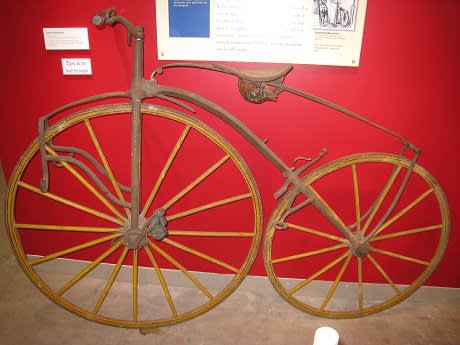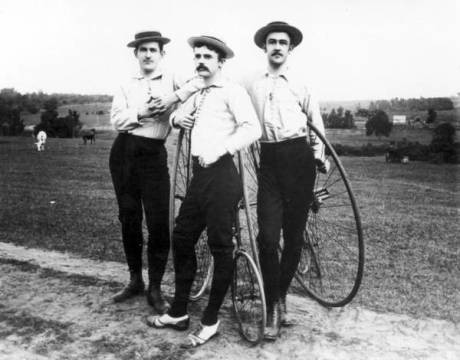Read time – 5 minutes
In 1817, Karl Drais invented the first two wheeled mode of transport. In the subsequent 200 years, the creation we know as the bicycle has gone from gimmick to household favourite. In honour of its 200th anniversary, we’re celebrating all things bike.
 Exodus bikes, Chile
Exodus bikes, Chile
Necessity is the mother of invention, and the bicycle was born from the necessity of easy transportation at a time when horses were in short supply. Thanks to its efficiency and easy maintenance (compared to a horse!) the Velocepide (or running machine as it was also known) became popular. The rider simply sat over the machine and ‘ran’ using their legs to propel themselves forward. Sadly it didn’t last long as it was promptly banned from use on public sidewalks after causing plenty of accidents, and impossible to use on the cobbled roads.
 The American Velocipede, a wood engraving sketched by Theodore R. Davis and published in Harper’s Weekly, 1868. Source: Wikimedia Commons.
The American Velocipede, a wood engraving sketched by Theodore R. Davis and published in Harper’s Weekly, 1868. Source: Wikimedia Commons.
It took 46 years for someone to have another go at designing a bicycle, but in 1863 the boneshaker was born. A drastic re-design over Drais’ machine saw pedals fitted to the front wheel with a direct drive allowing the rider to pedal, reaching higher speeds and travel further. The bike got the name the boneshaker thanks to its unforgiving solid metal frame and small solid wheels which literally bounced over the cobbled streets.
 A boneshaker, circa 1868, in a museum. Source: Wikimedia Commons.
A boneshaker, circa 1868, in a museum. Source: Wikimedia Commons.
With the aim of making a bicycle more comfortable and capable of traveling larger distances, the penny farthing/Ordinary machine/High wheeler was invented in 1870 and was the first machine to officially be called a bicycle. The idea was that the larger front wheel would roll more smoothly over bumps and its larger circumference would travel further in a single pedal stroke which was needed as it was a fixed wheel design meaning you couldn’t stop pedaling and coast. While these all sound like good improvements, they also made the high wheel an extremely dangerous machine. Any sudden stop of the front wheel would send the rider flying over the handlebars and face first into the ground, not ideal!
 Three men with their penny farthings. Source: Wikimedia Commons.
Three men with their penny farthings. Source: Wikimedia Commons.
In 1880 probably the biggest progression in bicycle design came about with the launch of the safety bicycle – basically the same design we ride today! Thanks to improvements in metal work, engineers were able to make a chain small and strong enough to be used to power the rear wheel of a bicycle. This meant that the rider didn’t have to straddle the front wheel and sit six feet in the air. Now, the rider could be safely positioned in the centre of the bike and the machine could have two same size wheels to lower the centre of gravity and vastly improve the safety and usability. This leap forward changed the public’s perception of a bike from a dangerous toy to a usable, practical and affordable means of transport. By 1890 the safety bicycle had been copied worldwide and made the penny farthing obsolete, with further improvements like inflatable tyres, gears and better brakes the sales of bicycles boomed and with that came further improvements.
 Advert for Peugot cycles, showing the bicycle in comparison to horse. Source: Wikimedia Commons.
Advert for Peugot cycles, showing the bicycle in comparison to horse. Source: Wikimedia Commons.
It didn’t take long for people to realise that a bicycle was a great way to see the world and in 1920 Annie Londonderry became the first woman to cycle around the world and in 1930 The Cyclists’ Touring Club started offering week long cycling holidays around the UK for a pricey £3!
As cycle racing grew in popularity, a demand was created for lighter weight and more durable bicycles and in the 1970s manufacturers began to experiment with aluminium frames rather than steel. This progression for lighter and faster bikes grew and in 1999 a certain American cyclist won the Tour de France on a carbon fibre Trek OCLV 5200 bicycle, which quickly became the fastest selling bike in the USA. Its popularity launched the mass production of carbon fibre bicycles worldwide.
 Cycling in Spain
Cycling in Spain
Today the array of different bicycles on offer is overwhelming; you can walk into a shop and purchase anything from a steel folding bike to a top end carbon fibre race machine off the shelf. One of the most exciting new developments is the fat bike. They are essentially mountain bikes fitted with 4-inch wide tyres, providing unrivalled grip across snowy landscapes and over snow-packed singletrack.
In 200 years the humble bicycle has transformed the way we explore the world. Whether you use a bike to commute to work, ride around the park or are setting out on transcontinental expedition, the main design and principles are the same as they were hundreds of years ago and don’t look likely to change any time soon. Celebrate 200 years of the bike with a cycling adventure.





